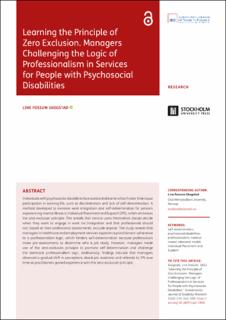| dc.contributor.author | Fossum Skogstad, Line | |
| dc.date.accessioned | 2024-01-04T13:05:54Z | |
| dc.date.available | 2024-01-04T13:05:54Z | |
| dc.date.created | 2023-12-22T07:30:21Z | |
| dc.date.issued | 2023 | |
| dc.identifier.citation | Scandinavian Journal of Disability Research. 2023, 25 (1), 431-444. | en_US |
| dc.identifier.issn | 1501-7419 | |
| dc.identifier.uri | https://hdl.handle.net/11250/3109858 | |
| dc.description.abstract | Individuals with psychosocial disabilities face substantial barriers that hinder their equal
participation in working life, such as discrimination and lack of self-determination. A
method developed to increase work integration and self-determination for persons
experiencing mental illness is Individual Placement and Support (IPS), which embraces
the zero-exclusion principle. This entails that service users themselves should decide
when they want to engage in work (re-)integration and that professionals should
not, based on their professional assessments, exclude anyone. The study reveals that
managers in healthcare and employment services experience practitioners’ adherence
to a professionalism logic, which hinders self-determination because professionals
make pre-assessments to determine who is job ready. However, managers made
use of the zero-exclusion principle to promote self-determination and challenge
the dominant professionalism logic. Additionally, findings indicate that managers
observed a gradual shift in perceptions about job readiness and referrals to IPS over
time as practitioners gained experience with the zero-exclusion principle | en_US |
| dc.language.iso | eng | en_US |
| dc.rights | Navngivelse 4.0 Internasjonal | * |
| dc.rights.uri | http://creativecommons.org/licenses/by/4.0/deed.no | * |
| dc.title | Learning the Principle of Zero Exclusion. Managers Challenging the Logic of Professionalism in Services for People with Psychosocial Disabilities | en_US |
| dc.type | Peer reviewed | en_US |
| dc.type | Journal article | en_US |
| dc.description.version | publishedVersion | en_US |
| cristin.ispublished | true | |
| cristin.fulltext | original | |
| cristin.qualitycode | 1 | |
| dc.identifier.doi | 10.16993/sjdr.1008 | |
| dc.identifier.cristin | 2217099 | |
| dc.source.journal | Scandinavian Journal of Disability Research | en_US |
| dc.source.volume | 25 | en_US |
| dc.source.issue | 1 | en_US |
| dc.source.pagenumber | 431-444 | en_US |

